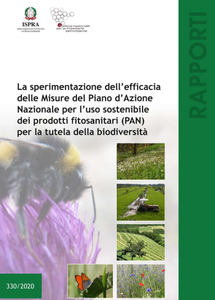The experimental assessment of the effectiveness of the measures provided for by the National Action Plan for the sustainable use of plant protection products (NAP)
ISPRA 330/2020 report highlights the results of an experimental assessment of the effectiveness of the measures provided for by the National Action Plan for the sustainable use of plant protection products (NAP - defined according to EU Directive2009/128/CE) aimed at protecting biodiversity.
The project, funded by the MATTM and coordinated by ISPRA, was carried out between 2015 and 2020 in collaboration with ARPA Piemonte, ARPA Lazio, University of Turin, University of Rome “Tor Vergata”. This research was implemented by analyzing differences between conventional and organic crops in rice fields and vineyards (in Piedmont), arable land and hazelnut groves (in Lazio), starting from the assumption that organic method is more compatible with the conservation of biodiversity, as indicated in Measure 13 of the NAP Guidelines (referred to in Ministerial Decree 10/3/2015). The research was carried out by analyzing differences between the results of the monitoring in each pair of field (organic vs conventional - in 24 farms) of different status and impact descriptors of selected bioindicators along the food chain of agroecosystems (soil fauna, terrestrial arthropods, flora, vegetation, flora of beekeeping interest, apoidea, diurnal lepidoptera, odonates, amphibians, lizards, birds and bats) were compared. In the selected fields, water and soil samples were also analysed to assess the presence of residues of plant protection products and their ecotoxicity, and to define the physico-chemical characteristics of soils, which were related to the results of the bioindicators monitoring activities.
In general, although no particular criticalities were identified from a chemical and ecotoxicological point of view (except for some that go beyond the use of products of the considered farms), from the comparison of data collected in the two types of fields, it emerged that plant and animal communities are better structured and more complex in organic fields than in conventional ones.
The experimentation confirmed the effectiveness of the measures of the NAP Guidelines concerning the protection of biodiversity (Measures no. 13 and 16) and made it possible to define proposals for monitoring protocols that can be used by ARPA/APPA, Regions and applied in protected area and Natura 2000 sites, to verify the effects of plant protection products on species, habitats that characterize agroecosystems. The study also allowed to define further management guidelines for the considered agroecosystems, to make agricultural activity, in particular in protected areas, Natura 2000 sites and Ramsar areas, more compatible with the conservation of biodiversity.
Download the publication (pdf 9,8 Mb)

